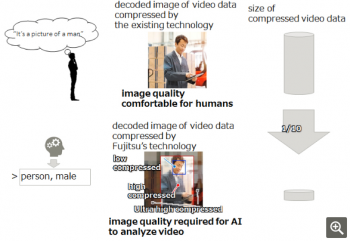
Fujitsu Laboratories Ltd. has developed a technology for compressing ultra-high-definition, high-volume video data to the minimum size needed for AI video recognition applications. This technology can compress video data to just one tenth the size of data prepared using conventional compression technology intended for visual confirmation by humans.
In recent years, there has been a sharp increase in demand for AI analysis of video data in various business areas. The spread of 5th-generation mobile communications system, is expected to contribute to an explosive increase in the number of ultra-high-definition video images captured by cameras, as well as many images captured on the street and on production lines.
In developing this new compression technology, Fujitsu focused on an important divergence in the way in which AI and humans recognise images. Namely, AI and humans tend to differ in the areas of the image that are emphasised as important for judgment when recognising people, animals, or objects in video data. Fujitsu has developed a technology to automatically analyse the areas that AI values and to compress data to the minimum size that AI can recognise. Without compromising recognition accuracy, this makes it possible to analyse a large amount of video data, and at the same time significantly reduce operating and data transmission costs. It is also anticipated that the technology will allow users to analyse more advanced video data by combining multiple video data stored in the cloud, sensor data, and performance data such as sales data.
Background and Challenges
Technology for analysing images using AI has been developing rapidly in recent years, and is expected to be one of the driving forces for digital transformation in many companies in a variety of industries. The demand for AI analysis is expected to increase even further with the sophisticated 5G mobile services arriving in 2020, accompanied by the increasing use of ultra-high-definition 4K and 8K cameras and large amounts of video data for applications including behavioural analysis in the manufacturing and retail industries.
Despite this, the processing demands for deep learning techniques used for image analysis present considerable challenges. One effective technique for securing computing power to deal with these tasks is to process in conjunction with the cloud, but since video data is often very resource-intensive, there is a need for high-compression technology that can transmit all video data to the cloud without compromising quality so that network bandwidth does not become overburdened.
 (0)
(0) (0)
(0)Archive
- April 2024(81)
- March 2024(112)
- February 2024(109)
- January 2024(95)
- December 2023(56)
- November 2023(86)
- October 2023(97)
- September 2023(89)
- August 2023(101)
- July 2023(104)
- June 2023(113)
- May 2023(103)
- April 2023(93)
- March 2023(129)
- February 2023(77)
- January 2023(91)
- December 2022(90)
- November 2022(125)
- October 2022(117)
- September 2022(137)
- August 2022(119)
- July 2022(99)
- June 2022(128)
- May 2022(112)
- April 2022(108)
- March 2022(121)
- February 2022(93)
- January 2022(110)
- December 2021(92)
- November 2021(107)
- October 2021(101)
- September 2021(81)
- August 2021(74)
- July 2021(78)
- June 2021(92)
- May 2021(67)
- April 2021(79)
- March 2021(79)
- February 2021(58)
- January 2021(55)
- December 2020(56)
- November 2020(59)
- October 2020(78)
- September 2020(72)
- August 2020(64)
- July 2020(71)
- June 2020(74)
- May 2020(50)
- April 2020(71)
- March 2020(71)
- February 2020(58)
- January 2020(62)
- December 2019(57)
- November 2019(64)
- October 2019(25)
- September 2019(24)
- August 2019(14)
- July 2019(23)
- June 2019(54)
- May 2019(82)
- April 2019(76)
- March 2019(71)
- February 2019(67)
- January 2019(75)
- December 2018(44)
- November 2018(47)
- October 2018(74)
- September 2018(54)
- August 2018(61)
- July 2018(72)
- June 2018(62)
- May 2018(62)
- April 2018(73)
- March 2018(76)
- February 2018(8)
- January 2018(7)
- December 2017(6)
- November 2017(8)
- October 2017(3)
- September 2017(4)
- August 2017(4)
- July 2017(2)
- June 2017(5)
- May 2017(6)
- April 2017(11)
- March 2017(8)
- February 2017(16)
- January 2017(10)
- December 2016(12)
- November 2016(20)
- October 2016(7)
- September 2016(102)
- August 2016(168)
- July 2016(141)
- June 2016(149)
- May 2016(117)
- April 2016(59)
- March 2016(85)
- February 2016(153)
- December 2015(150)